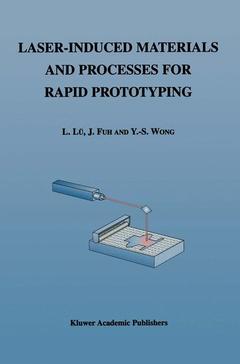Laser-Induced Materials and Processes for Rapid Prototyping, Softcover reprint of the original 1st ed. 2001
Langue : Anglais
Auteurs : Li Lü , Fuh J., Yoke-San Wong

The term rapid prototyping (RP) refers to a generic group of emerging technologies that enable very quick fabrication of engineering components primarily targeted for prototyping applications. With RP, very complex three dimensional parts or prototypes can be fabricated without the need of costly tooling and machining. This inevitably leads to much shorter design cycle time and lower cost of building a prototype. Its manifold benefits include significant productivity gains, cost saving, and shortened development time to introduce concept models. As such, RP technologies have attracted tremendous R&D interests from both academia and industry in the past decade. Many different processes and materials have been commercialized and used in industry primarily for the fabrication of physical prototypes. More recent interests in RP technologies are towards functional applications of the fabricated parts, such as in rapid tooling applications and replacements of damaged components. Many processes and materials have been commercialized but are yet to be able to fulfill the aforementioned functional requirements because of limited mechanical strengths of the fabricated parts.
1 Introduction.- 1.1 Overview of rapid prototyping and manufacturing.- 1.2 Laser-induced rapid prototyping.- 1.3 RP process characterization and modeling.- 1.4 RP technology trends.- 1.5 References.- 2 Fundamentals of Laser-lithography Processes.- 2.1 Laser-lithography.- 2.2 Laser scanning in LL process.- 2.3 Fundamental relationships.- 2.4 Characteristics of photo-polymerization.- 2.5 Summary.- 2.6 References.- 3 Material Characterization of Laser-lithography Built Parts.- 3.1 Mechanical properties of LL parts.- 3.2 Analyses of degree of curing.- 3.3 Distortion analysis by Moire method.- 3.4 Summary.- 3.5 References.- 4 Improvements of Mechanical Properties by Reinforcements.- 4.1 Introduction.- 4.2 Fiber-reinforced photo-polymer.- 4.3 AEROSIL-mixed photo-polymer.- 4.4 Improvements in LL-process.- 4.5 Summary.- 4.6 References.- 5 Selective Laser Sintering.- 5.1 Principle of laser sintering.- 5.2 Process of selective laser sintering.- 5.3 Liquid phase sintering in SLS.- 5.4 Commercial applications.- 5.5 Metal powders for laser sintering.- 5.6 Densification.- 5.7 Mechanical property.- 5.8 Summary.- 5.9 References.- 6 Metal-Based System via Laser Melting.- 6.1 Selective laser melting process.- 6.2 Metal powders.- 6.3 Composites.- 6.4 Summary.- 6.5 References.- 7 Laser Sintering of Ceramics.- 7.1 Fabrication of ceramic parts using SLS.- 7.2 SLS of ceramic parts.- 7.3 Summary.- 7.4 References.- 8 Characterization, Modeling and Optimization.- 8.1 Introduction.- 8.2 Modeling of RP part fabrication.- 8.3 Optimal orientation.- 8.4 Direct slicing of CAD models.- 8.5 Decision support for process optimization and selection.- 8.6 Summary.- 8.7 References.- 9 Rapid Tooling and Its Applications.- 9.1 Rapid tooling development.- 9.2 Rapid tooling techniques and applications.- 9.3 RT for injection molding - a case study.- 9.4 Application to EDM electrode fabrication.- 9.5 Summary.- 9.6 References.
Date de parution : 03-2014
Ouvrage de 267 p.
15.5x23.5 cm
Date de parution : 06-2001
Ouvrage de 267 p.
15.5x23.5 cm
Mots-clés :
ceramics; design; development; laser; Laser Melting; machining; material; modeling; Rapid Prototyping; Rapid Tooling; selective laser sintering; sintering
© 2024 LAVOISIER S.A.S.



